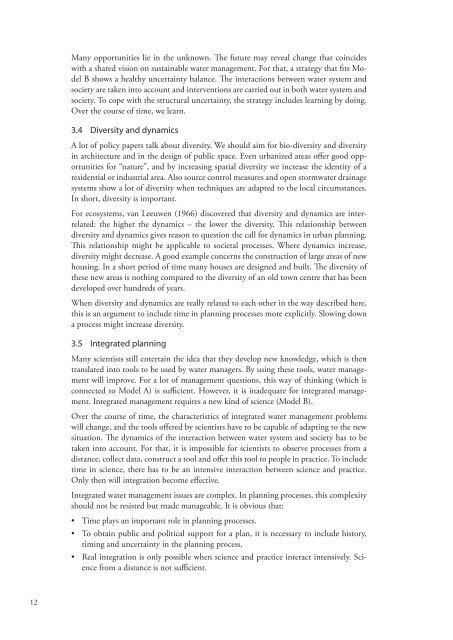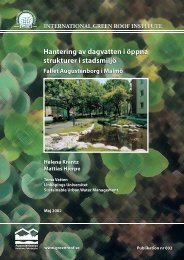New Approach to Sustainable Stormwater Planning - Visit WordPress
New Approach to Sustainable Stormwater Planning - Visit WordPress
New Approach to Sustainable Stormwater Planning - Visit WordPress
Create successful ePaper yourself
Turn your PDF publications into a flip-book with our unique Google optimized e-Paper software.
12<br />
Many opportunities lie in the unknown. The future may reveal change that coincides<br />
with a shared vision on sustainable water management. For that, a strategy that fits Model<br />
B shows a healthy uncertainty balance. The interactions between water system and<br />
society are taken in<strong>to</strong> account and interventions are carried out in both water system and<br />
society. To cope with the structural uncertainty, the strategy includes learning by doing.<br />
Over the course of time, we learn.<br />
3.4 Diversity and dynamics<br />
A lot of policy papers talk about diversity. We should aim for bio-diversity and diversity<br />
in architecture and in the design of public space. Even urbanized areas offer good opportunities<br />
for “nature”, and by increasing spatial diversity we increase the identity of a<br />
residential or industrial area. Also source control measures and open s<strong>to</strong>rmwater drainage<br />
systems show a lot of diversity when techniques are adapted <strong>to</strong> the local circumstances.<br />
In short, diversity is important.<br />
For ecosystems, van Leeuwen (1966) discovered that diversity and dynamics are interrelated:<br />
the higher the dynamics – the lower the diversity. This relationship between<br />
diversity and dynamics gives reason <strong>to</strong> question the call for dynamics in urban planning.<br />
This relationship might be applicable <strong>to</strong> societal processes. Where dynamics increase,<br />
diversity might decrease. A good example concerns the construction of large areas of new<br />
housing. In a short period of time many houses are designed and built. The diversity of<br />
these new areas is nothing compared <strong>to</strong> the diversity of an old <strong>to</strong>wn centre that has been<br />
developed over hundreds of years.<br />
When diversity and dynamics are really related <strong>to</strong> each other in the way described here,<br />
this is an argument <strong>to</strong> include time in planning processes more explicitly. Slowing down<br />
a process might increase diversity.<br />
3.5 Integrated planning<br />
Many scientists still entertain the idea that they develop new knowledge, which is then<br />
translated in<strong>to</strong> <strong>to</strong>ols <strong>to</strong> be used by water managers. By using these <strong>to</strong>ols, water management<br />
will improve. For a lot of management questions, this way of thinking (which is<br />
connected <strong>to</strong> Model A) is sufficient. However, it is inadequate for integrated management.<br />
Integrated management requires a new kind of science (Model B).<br />
Over the course of time, the characteristics of integrated water management problems<br />
will change, and the <strong>to</strong>ols offered by scientists have <strong>to</strong> be capable of adapting <strong>to</strong> the new<br />
situation. The dynamics of the interaction between water system and society has <strong>to</strong> be<br />
taken in<strong>to</strong> account. For that, it is impossible for scientists <strong>to</strong> observe processes from a<br />
distance, collect data, construct a <strong>to</strong>ol and offer this <strong>to</strong>ol <strong>to</strong> people in practice. To include<br />
time in science, there has <strong>to</strong> be an intensive interaction between science and practice.<br />
Only then will integration become effective.<br />
Integrated water management issues are complex. In planning processes, this complexity<br />
should not be resisted but made manageable. It is obvious that:<br />
• Time plays an important role in planning processes.<br />
• To obtain public and political support for a plan, it is necessary <strong>to</strong> include his<strong>to</strong>ry,<br />
timing and uncertainty in the planning process.<br />
• Real integration is only possible when science and practice interact intensively. Science<br />
from a distance is not sufficient.



